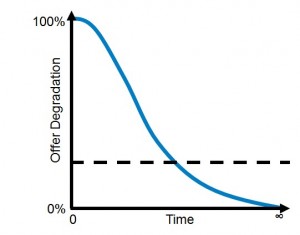In our wonderfully complex world of digital media, with on-line all-the-time connectivity, social media, big data opportunities (and challenges), it's never been more challenging (and at the same time easy) for marketers to use money wisely. Technology has accelerated the pace of doing business and one consequence is the common perception of saturation - and no medium is more glaring in this regard than email.

We all get too many emails, and in many places regulation drives the need to have easy opt-outs, so the price to pay for an overly active outbound marketing campaign can be quite steep.
So let me start with a confession. As a marketing analytics manager, I have never challenged a contact policy. By contact policy, I am talking about the rules such as ‘Don’t send more than one email a week’ or'Don’t contact a customer by telephone more than once a quarter’. I like to describe these as the ‘X in Y’ type of contact policies. They always seemed reasonable as the high touch and high value products had bigger windows than the low touch and low value products, so were probably in line with what customers wanted.
I support a lot of optimisation projects now, and contact policy is a central piece to the optimisation jigsaw, so I get to see how it varies across territories and industries. But whilst the X and Y in the ‘X in Y rule’ varies significantly, the one invariable is that none of them are analytically driven. Yet in the increasingly digital world, with its new channels, with more products to be sold and communications made, with more organisations making them, to customers with more devices…..but with less time, it seems appropriate to manage this more efficiently, doesn’t it?
Now some may say that in the digital world that contact policy is not required – after all everything can be trigger- or rules-based, and whilst that is clearly debatable, even in the digital world, I think it is beyond debate that if a customer abandons a cart 20 times in one day – they don’t need 20 SMSs or emails of phone calls to remind them of this fact….and the twentieth SMS is unlikely to get a better response than the previous nineteen messages did.
But what is the limit – and how should we derive it?
It seems to me there are two core drivers behind what we might try to achieve with a contact policy:
- Reduce cost / increase response
That is, don’t sent communications that, because there were other communications sent recently, are less likely to get a response, making it uneconomical. - Increase customer satisfaction
That is, don’t upset the customer with too many communications.
Reduce Cost/Increase Response
To achieve the first objective, there may be natural tests that have occurred – for example some customers were contacted one week apart, others two weeks apart. This can help to build a degradation curve, and the definition of degradation here being the drop in actual response versus the expected response. So for example if a model is telling you to expect 5% response, but you get 4% response, then there is 20% degradation.
 I’ve used a bit of artistic licence with the curve to the right, but I am pretty comfortable that the end points are correct. That is, if you contact a customer with the same offer, an infinitesimal time after the first offer, there is probably going to be 100% degradation of response for that second communication. Similarly, if you leave it a long enough time between offers, response will return to what was expected, and so there will be no degradation.
I’ve used a bit of artistic licence with the curve to the right, but I am pretty comfortable that the end points are correct. That is, if you contact a customer with the same offer, an infinitesimal time after the first offer, there is probably going to be 100% degradation of response for that second communication. Similarly, if you leave it a long enough time between offers, response will return to what was expected, and so there will be no degradation.
The dotted line can then be established so that an appropriate ROI or other relevant KPI can be achieved, and the contact rule is set up appropriately. For example if response degrading 50% is acceptable, and this happens at 2 weeks, then a ‘1 in 2 week’ contact rule probably makes sense.
Of course this curve could vary by product, channel, customer segment etc, and it may not be extremely accurate, but it would be interesting to make a start on finding out what it looks like, right?
Increase Customer Satisfaction
To achieve the second objective – to increase customer satisfaction - I would first of all spin it around and describe it as reducing customer dissatisfaction. This can be easier to measure using KPIs such as attrition (churn) rates, or opt out rates.
Most marketers have the tools to achieve this – it’s similar to building a response model, but the thing we are trying to predict is ‘dissatisfaction’ (i.e. the customer attrited, or the customer opted out) the inputs are the communications that a customer received (and some additional variables built up on these).
So it may be the case that a particular email caused the opt outs, but equally, it may be the case that customers that received 10 emails in a month were more likely to opt out, but those that received less than 5 didn’t opt out more than the average. A traditional logistic regression model will highlight these negative trigger points for the customer, and so a contact rule can be set up to avoid it – e.g. no more than 5 emails per month.
Clearly there are many caveats around both analytical approaches, and there are other ways of achieving a good outcome (e.g. market research, or including past contacts in existing models), but it’s worth highlighting that the data and the toolset to do this more analytically is probably sitting there in many organisations right now, and with the current plethora of communications that customers are receiving, now may be a good time to work out when is the right time.
Whilst having a set of customer level contact policies is going to be much more customer focused, and will lead to fewer opt outs and reduced cost….it will raise a few more challenges. Multiple contact rules are hard to manage, especially across customers and channels and product sets. Add the continued responsibility to stay focused on maximising sales, increasing revenue, and meeting operational lead volume requirements, and you have a situation where you cannot use money wisely by managing with spreadsheets.
An analytically-driven process, such as SAS Marketing Optimization can step up to manage the complexity. With easily configurable customer level contact rules, constraint management and multiple goal maximisation, to name just a few capabilities, it’s the perfect way to achieve a more customer focused approach, that still meets business requirements. You're welcome to explore more at www.sas.com/customerjourney or contact us and ask for me or any of my colleagues.
